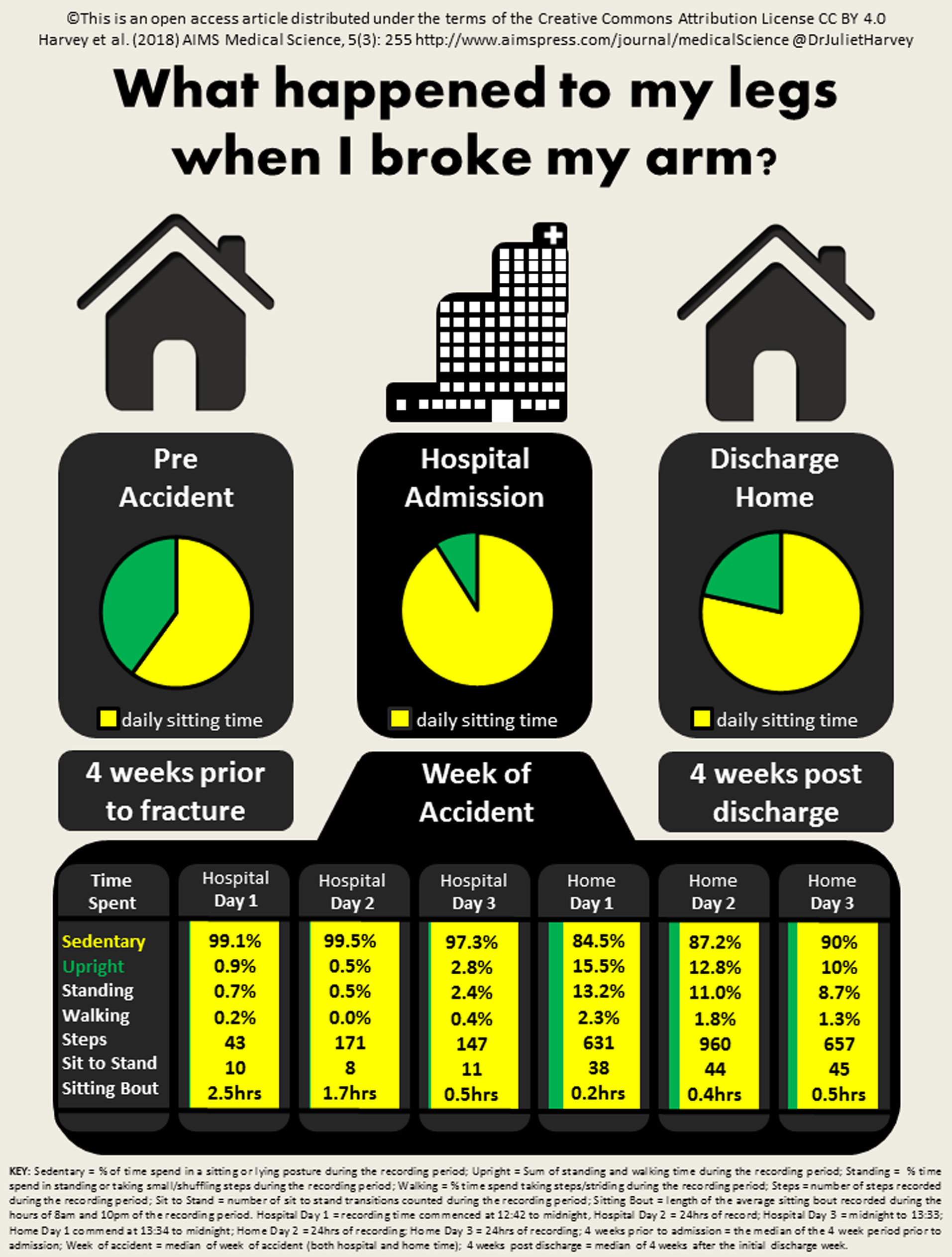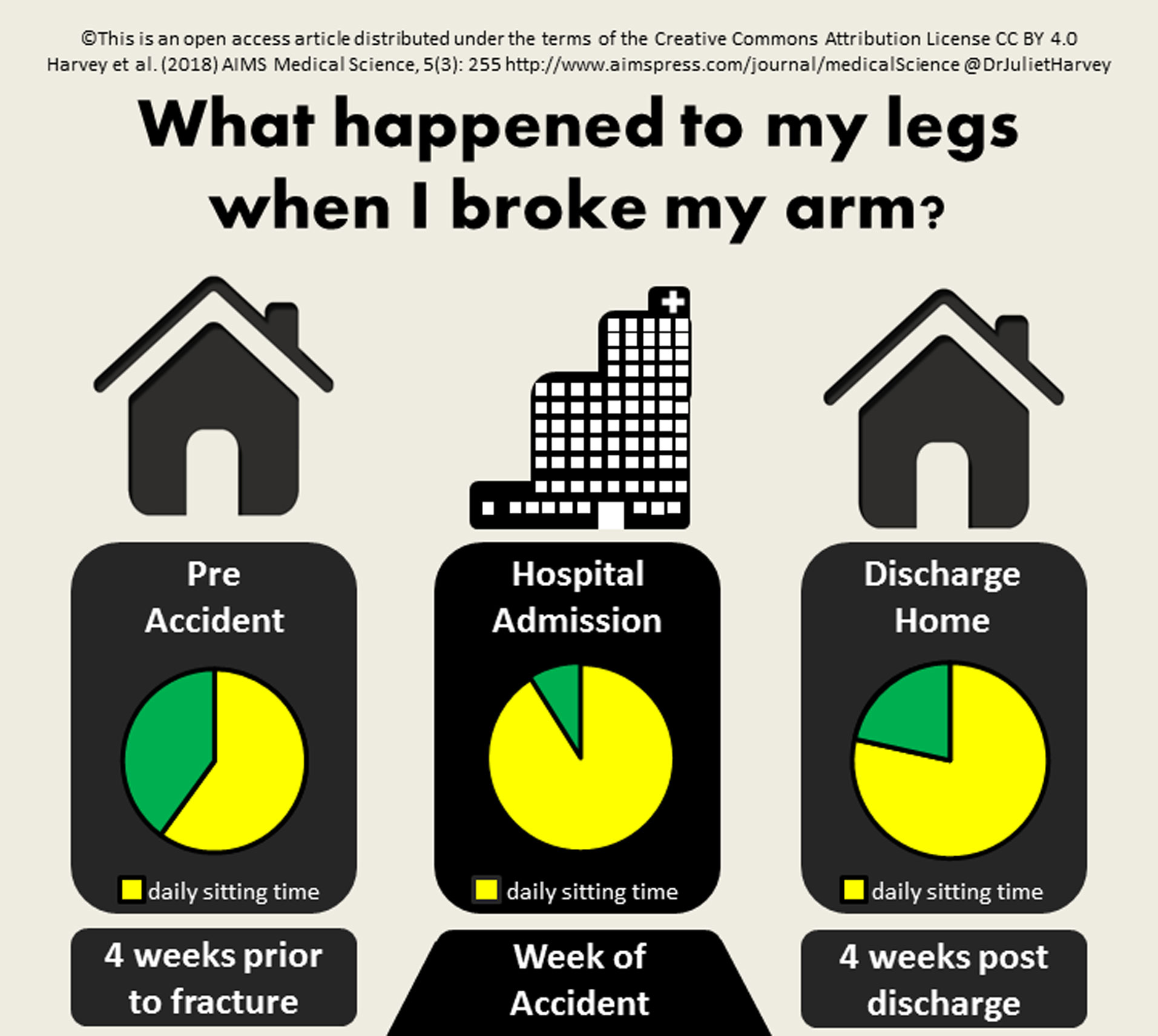1. Introduction
Sedentary behaviour is defined by both posture (sitting or reclining) and low energy expenditure (< 1.5 Metabolic Equivalent of Task [METS]) during waking hours [1]. Objective data examining sedentary time of older adults in the hospital environment have indicated 80-98% of the day is reported to be sedentary when measured by inclinometer [2,3,4,5]. The findings of these studies tend to report the rehabilitation stage of disease/injury management, with the exception of hip fracture management where there is some data available from day 2 post surgery [4,5]. There is a dearth of information on older adults' upper limb injuries effect on sedentary behaviour. In addition, pre-injury activity levels have only been recorded retrospectively by patient report at all ages [5,6]. The case report presents the measurement of the participant's sedentary time before the incident causing an upper limb injury, during hospitalisation and post discharge when the participant returned home.
2. Incident
The Stomp Out (prolonged) Sitting (SOS) intervention study [7] involved monitoring of sedentary behaviour by activPAL inclinometer. During the course of this study one participant unfortunately had a fall causing upper limb injury. The participant was a 72 year old female living on her own in sheltered housing with no fall history in the last year. Prior to the fall she had chronic lower back pain and was independent with activities of daily living and independently mobile without the use of a walking aid. On admission to hospital she was found to have bruising to the right side of her body, an orbital fracture and proximal humerus fracture, which was managed conservatively with no other complications. She was discharged home with a package of care after 3 days and follow-up physiotherapy for her shoulder in her local clinic.
3. Materials and methods
The Glasgow Caledonian University School of Health and Life Sciences Ethical Committee gave approval and the participant gave written informed consent (HLS12/59). The full study protocol and data collection methods are described in detail in the associated paper [7]. In summary, from week 1 of the study onwards participants were asked to wear the activity monitor 24 hours a day. The monitor was applied by the researcher on day one of the study. After 7 days the first set of data was retrieved and the second monitor was applied to the opposite leg. At baseline and post study the participants completed validated functional tests including Timed “Up and Go” (TUG) [8] and 30 sec Chair Rise tests [9] to assess mobility and lower limb strength.
The data were produced by the activPAL inclinometer activity monitor (PAL Technologies). For the case study, the data subsets were sourced from the SOS study [7]. The activPAL inclinometer is a thigh mounted objective monitor shown to be a highly accurate method of measuring sitting posture in older adults [10,11]. The monitors were covered in medical grade waterproof packets. The monitors were applied to the mid-thigh using an adhesive pad (“activPAL Stickie”), this was then covered with a hypoallergenic tape (Opsite Fexifix). The participants were instructed to remove the monitor and telephone the researcher if any adverse event occurred. The monitor also displayed the wording “activity monitor” and a contact number in case the monitor was lost or the user was in a situation where they were unable to explain its purpose.
The activity and sedentary time data were generated from activPAL proprietary software. The sedentary behaviour data were analyzed using the data from the activity monitors following the protocol of Chastin and Granat (2010) [12]. The data for the case study infographic was processed using Excel 2010 to provide the descriptive statistics for the image. The results were presented as time within the environment (either hospital or home). The time of the accident, time of ambulance journey, the hospital admission and discharge time was self-reported by the participant retrospectively whilst viewing the activPAL monitor output to get a very specific marker of the time where the change in environment takes place.
Sedentary time was defined as both sitting and lying time during the recording period (indicated by the colour yellow on the infographic). Standing time was time spent standing or taking small/shuffling steps; walking time was time spent taking steps/striding; upright time was the sum of standing time and walking time (indicated as green on the infographic); steps were the number of steps recorded; sit to stand was the number of sit to stand transitions recorded. The sitting bout was the average sitting bout length recorded during the hours of 8 am and 10 pm of the recording period. The first pie chart on the left of the infographic shows the median of 4 weeks prior to admission. The second pie chart shows the median of the week of the accident (both time in hospital and return home). The third pie chart shows the median of 4 weeks after the week of incident.
The target audience for the infographic was professionals working with older adults especially those working in the acute setting. Although the case study described traumatic orthopaedic injury and management, the audience is not refined to this setting. Guideline on production of infographic material produced by Scott et al. (2018) [13] were followed.
4. Results
The results are presented as an infographic (Figure 1, and summary in Figure 2) which describes the activity patterns of 3 days in hospital and 3 days post discharge in the context of the months surrounding admission. On the day of the injury the participant reported she was transferred to hospital by ambulance and admitted at around 12:30 hrs, she was discharged on day 3 leaving the hospital at around 13:30 hrs (matched to day 1 hospital 12:42 hrs data point and day 3 13:33 hrs data point respectively). Therefore, day 1 hospital data collection time = 11 hrs 18 mins; day 2 hospital data collection time = 24 hrs; day 3 hospital data collection time = 13 hrs 33 mins; day 1 home data collection time = 10 hrs 26 mins; day 2 at home data collection time = 24 hrs; day 3 at home data collection time = 24 hrs.
It is clear from the infographic that considerable sedentary time (98.6 ± 1.2% of the data collection period) is accrued during the acute hospital stay. Following discharge sedentary time decreased, but even 4 weeks after discharge the sedentary time remained substantially higher at 78.5 ± 3.9% compared to pre-injury levels of 64.8 ± 7.5%. It is interesting to note that at baseline the participant's TUG time was 10 sec, at study follow-up this had increased to 13 sec. Her 30 sec Chair Rise test score was 10 rises at baseline and 8 post study, indicating a reduction in her physical capacity.
5. Discussion and conclusion
The System of Sedentary Behaviour (SOS) Framework Project [14] explored the complexity of the determinants of sedentary behaviour through consensus within the research community. With 92% consensus, the group ranked “Institution and Home Setting” the number 1 sedentary behaviour research priority. This is understandable as hospital admissions have an injurious effect on an individual's physical function, activity levels and sedentary time and increasing upright time at this point has been associated with reduced fear of falls and better function [15,16].
The infographic case study demonstrates an individual's journey through the system of hospital care and home dwelling both before and following a traumatic injury. A very detailed description of activity and sedentary behaviour is presented. Of particular note are the high levels of sedentary time within the inpatient setting, but of equal interest is the stark change in sedentary time and activity was observed within hours of being home. In terms of activity this is considered a positive effect on activity levels, but the sustainability of this rise seems to dwindle within days. Therefore, this case is a good example of why we must support individuals on the transition back to the home environment and encourage an increase in activity.
This case study infographic is unique in both presentation and content, however finding on high levels of sedentary behaviour in the acute inpatient setting are supported by other work examining lower limb orthopaedic injury. Within the first week of admission for management of hip fracture, levels of between 1 and 3% of time upright were reported [16,17,18]. Even within rehabilitation wards levels of 3% upright time are measured [19]. Bernhardt et al. (2005) reported 14% upright time within a week of discharge, compared to 27% in age and gender matched older adults dwelling in the community [20]. Therefore, confronting high levels of sedentary time should be a priority across health professions and stakeholders working with older adults both in hospital and in community settings [21].
The report demonstrates the detrimental consequences of an upper limb injury to activity levels of an older adult receiving normal care. The case report infographic can be used as an education tool that is meaningful to the real world setting.
Acknowledgements
This work was supported by Glasgow Caledonian University studentship and Scottish Innovation Voucher Scheme.
Conflict of interest
The authors have no conflict of interest.










 DownLoad:
DownLoad: 





